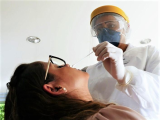Amid a steady rise in US COVID -19 cases led by a more transmissible subvariant, vaccine advisers for the Centers for Disease Control and Prevention (CDC) today recommended a booster dose of the Pfizer-BioNTech vaccine for children ages 5 though 11.
ACIP goes with stronger option
Earlier this week, the Food and Drug Administration (FDA) approved the vaccine booster for emergency use in younger kids. The move follows an early January recommendation for booster doses for kids in older age-groups.
CDC experts today said 35.4% of children ages 5 though 11 have had at least one COVID vaccine dose. Though researchers haven't had much time to track waning protection of vaccinated younger kids, they have shown waning over time after two doses in children ages 12 and older.
Given uncertainties about the limited numbers of kids in the younger age-group in the booster-dose clinical group and the timing of vaccination regarding a possible fall and winter wave, members of the CDC's Advisory Committee on Immunization Practices (ACIP) grappled with whether to say younger kids "may" or "should" get the third dose.
Many members of the group said they thought the "may" recommendation would help with clearer messaging about the booster dose and align the booster recommendation with that for other age-groups, including older kids. Some members, though, were swayed by the idea of boosters given closer to fall, while others said messages about kids' COVID-19 vaccination should be more targeted to ensure that kids receive their primary series.
At today's meeting, the recommendation passed with 11 yes votes, 1 no vote, and 1 abstention. The booster would be given as the same smaller 10-microgram dose that is administered for the primary series and would be given at least 5 months after the second dose.
Third doses are already recommended for immunocompromised kids ages 5 though 11, who are now recommended to get a fourth dose. The CDC director still needs to sign off on ACIP's recommendation before booster doses roll out to kids ages 5 though 11.
US COVID cases continue to rise
US COVID-19 activity continues to rise, led by the more transmissible BA.2.12.1 subvariant that was first detected in New York. Yesterday at a White House COVID-19 briefing, federal health officials said the nation was averaging 100,000 cases a day, and today the 7-day average for daily cases rose to 103,231, according to a New York Times analysis.
Though some cities with high community transmission have recommended that people return to masking in public indoor spaces, New York City Mayor Eric Adams said the city won't order a mask mandate at this time.
New forecast models from the CDC project that cases, hospitalizations, and deaths will continue to rise over the next 4 weeks.
WHO clears 11th vaccine for emergency use
The World Health Organization (WHO) today listed an eleventh COVID-19 vaccine for emergency use, a single-dose modified adenovirus vaccine (Convidecia) made by China-based CanSino Biologics. Earlier this month, the WHO's Strategic Advisory Group of Experts (SAGE) on Immunizations recommended use of the vaccine in adults based on data that suggest the vaccine is 64% effective against symptomatic infection and 92% effective against severe disease.
In other global developments:
- Shanghai, which has been on lockdown for more than 6 weeks, has now gone 5 days without new COVID-19 cases outside of quarantine areas, and city officials are allowing more people to leave their homes to get groceries, according to Reuters.
- North Korea today reported about 260,000 more suspected COVID-19 cases today, putting its total at nearly 2 million, according to CBS News, based on state media reports. It reported 1 more death, raising the total to 63. The country recently acknowledged its first outbreak, alarming global health officials who worry about an unvaccinated population and a lack of strong health infrastructure to handle the surge.



















